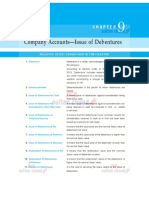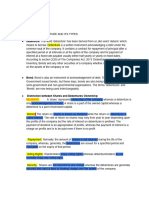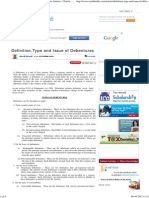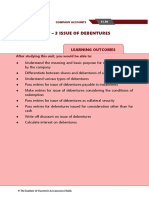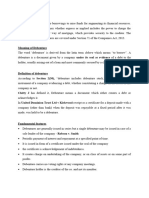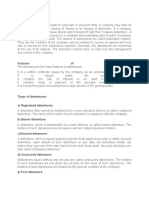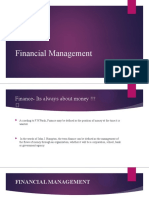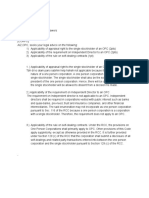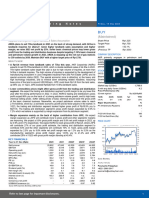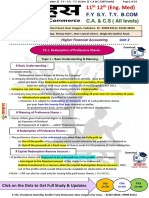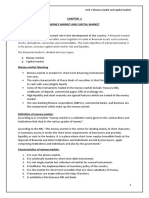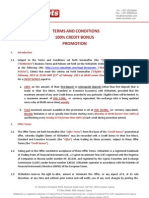Debenture
Uploaded by
aayanagrawal00Debenture
Uploaded by
aayanagrawal00Accounting For Companies – Issue of debenture CUET
Accounting For Companies – Issue of Debentures
According to section 2(30) of the Companies Act 2013, "Debenture includes debenture
stock, bonds and any other securities of a Company, whether constituting a charge on the
assets of the Company or not."
Types or Kinds of Debentures:
A Company may issue the following types of debentures:
1. Secured or Mortgage Debentures: These debentures are those which are secured
either on particular assets of the Company called fixed charge or on all assets of the
Company in general, called a floating charge. Fixed charge denies the Company from
dealing with mortgaged assets, whereas the floating charge does not prevent the
Company from using the assets. First mortgage debentures are those that have a first claim
on the assets charged and second mortgage debentures are those having a second claim on
the assets charged. In India, debentures have necessarily to be secured.
2. Unsecured or Naked Debentures: These debentures are those which are not given
any security. The holders of such debentures are treated as unsecured creditors at the time of
liquidation of the Company. Unless otherwise stated, a debenture is presumed to be secured.
3. Registered Debentures: Names and addresses of the holders of such debentures
are recorded in a register of the Company called, "Register of Debentureholders". Such
debentures are not freely transferable. The Transfer of such debentures requires the
execution of a proper transfer deed. Principal amount and interest on such a debenture is
paid to the person whose name appears in the Company's register.
4. Bearer Debentures: Names and addresses of the holders of such debentures are
not recorded in the Company and these debentures are transferable by mere delivery.
Payment of principal and interest is made to the bearer of such debentures.Coupons are
attached with these debentures and the interest is paid to such persons who produce the
coupons in the specified bank.
5. Redeemable Debentures: Redeemable debentures are those debentures which will
be repaid by the Company either in lump sum at the end of a specified period or by
instalments during the lifetime of the Company. Most of the debentures are generally of this
type.
6. Irredeemable or Perpetual Debentures: Irredeemable debentures are those
debentures which are not repayable by the Company during its life time. These debentures
are repayable only at the time of liquidation of the Company.
7. Convertible Debentures: Convertible debentures are those debentures which are
convertible into equity shares at the option of the company after a specified period. When
only a part of the amount of debenture is convertible into shares, such debentures are called
'Partly Convertible Debentures'. When the full amount of debenture is convertible into
shares, such debentures are called 'Fully Convertible Debentures'. SEBI Guidelines require
that where the conversion is to be made at or after 18 months from the date of allotment
but before 36 months, any conversion in part or whole shall be optional on the part of the
debentureholders. Convertible debentures are very popular these days, as they provide
liquidity, safety, capital appreciation and assured return to the investors.
FOR CLASSES & INFORMATION Page 1
Accounting For Companies – Issue of debenture CUET
Distinction Between a Share and a Debenture
S. Basis of Share Distinction
No. Debenture
1. Capital A share is a part of the Capital A debenture is a part of the
vsLoan of the Company, therefore, the loan and as such, the
shareholders are theowners of debentureholders are the
the Company. creditors of the Company.
2. Dividend vs A shareholder gets dividend A debentureholder gets
Interest from the Company interest from the Company.
3. Fluctuating or Dividend is paid only when The rate of interest is fixed
Fixed rate of there are profits. The rate of and it must be paid irrespective
Dividend or dividend may fluctuate from of the Company making a
Interest year to year depending upon the profit or incurring a loss.
profits and decision of the
directors.
4. Voluntary or It is at the option of the The amount of debentures
Compulsory Company to return the amount must be returned according to
Redemption of shares by buying back its own the terms of the issue.
shares.
5. Priority of In the case of winding up, the In the case of winding up, the
Repayment of payment of share capital is made payment of debentures is made
Principal in after the repayment of before the payment of share
Case of debentures. capital.
Winding up
6. Unsecured or A share is always unsecured. Debentures are usually
Secured Hence, they bear more risk. secured on the assets of the
Company. Hence, they bear
little risk.
7. Restriction on Under Section 53 of the There are no restrictions on
Issue at Companies Act 2013, shares the issue of debentures at
Discount cannot be issued at discount discount.
except sweat equity shares.
8. Voting Rights Share confers on its holder the A holder of debenture neither
right to participate in and vote at possesses any voting right in
Company's meetings. the Company's meetings nor
can-he participate in the
meeting.
Issue of Debentures
The procedure for the issue of debentures is very much similar to that of the issue
of shares.
Minimum Subscription
The Companies Act has not prescribed the minimum subscription. It has to
bedecided by the Company.
However, SEBI has prescribed that minimum 75% of the issue should be
subscribed before a Company proceeds to allot the debentures.
FOR CLASSES & INFORMATION Page 2
Accounting For Companies – Issue of debenture CUET
Debentures may be issued either at par, or at a premium or at a discount.
Following entries will be passed on the issue of debentures (assuming that the debentures
carry 8% interest)
1. On receipt of application money:
Bank A/c Dr.
To 8% Debenture Application A/c
(Application money received)
2. On Transfer of application money to Debenture Account:
8% Debenture Application A/c Dr.
To 8% Debentures A/c
(Application money transferred)
3. On refund of money on totally rejected applications:
8% Debenture Application A/c Dr.
To Bank A/c
(Application money returned on rejected applications)
4. On the transfer of surplus application money on partially accepted applications:
8% Debenture Application A/c Dr
To 8% Debenture Allotment A/c
(Transfer of excess application money to allotment A/c)
5. On making allotment money due:
8% Debenture Allotment A/c Dr.
To 8% Debentures A/c
(Allotment money due)
6. On receipt of allotment money :
Bank A/c Dr.
To 8% Debenture Allotment A/c
(Allotment money received)
7. On making the call money due:
8% Debenture First Call A/c Dr.
To 8% Debentures A/c
(First Call money due)
8. On receipt of call money:
Bank A/c Dr.
To 8% Debenture First Call A/c
(First Call money received)
If there are more than one call, separate entries for each call will be passed, likeabove.
Issue of Debentures at Discount
When the Company issues debentures at a price which is less than their face or nominal
value, the debentures are said to have been issued at a discount. There are no restrictions in
the Companies Act regarding the maximum limit for discount on debentures.
Discount or Loss on Issue of Debentures is a Capital loss. It should be written off in
the year it occurs.
FOR CLASSES & INFORMATION Page 3
Accounting For Companies – Issue of debenture CUET
IMPORTANT NOTE
Accounting Standard 16, Borrowing Cost prescribes that the discount or loss on issue of
debentures be written off in the year in which it is incurred, i.e ., in the year in which
debentures are allotted.
Discount or Loss on Issue of Debentures can be written off by debiting first to Securities
Premium Account (if it exists) and then from Statement of Profit and Loss.Following entry
is passed for writing off discount or loss on issue of debentures :
Securities Premium A/c Dr.
Or
Statement of Profit & Loss Dr.
To Discount/Loss on Issue of Debentures A/c
Discount being a loss, is recorded in the books of the Company by debiting"Discount
on Issue of Debentures A/c". Discount is presumed to be allowed at the time of allotment,
unless otherwise stated in the question.
Issue of Debentures for Consideration other than Cash
Just like shares, debentures may also be issued for consideration other than Cash, in
the following circumstances:
(1) Issue of Debentures to Promoters:
Promoters of a Company may be issued debentures in the Company for the services
rendered by them. The entry will be:
(i) Incorporation Costs or Preliminary Expenses Dr.
To Promoters' A/c
(Cost of Company's incorporation payable to promoters)
(ii) Promoter's A/c Dr.
To.% Debentures A/c
( .... % Debentures allotted to promoters)
(2) Issue of Debentures to Underwriters:
The Company may allot debentures to the underwriters to pay their commission.The
entries will be:
(i) Underwriting Commission A/c Dr.
To Underwriter's A/c
(Underwriting Commission due)
(ii) Underwriter's A/c Dr.
To .... % Debentures A/c
( .... % Debentures allotted to Underwriters for the
FOR CLASSES & INFORMATION Page 4
Accounting For Companies – Issue of debenture CUET
Commission due to them)
(3) Issue of Debentures to Vendors:
Sometimes a Company purchases some assets from the vendor and instead of paying
the vendor in cash, the Company may decide to issue debentures to the vendor in payment of
purchase consideration. Such an issue of debentures to vendors is known as issue of
debentures for consideration other than cash. Debentures can be issued to vendors at par,
at a premium or at a discount. Following entries will be passed for this purpose:
I. On Purchase of Business:
(a) When purchase consideration given is more than the net assets:
Sundry Assets A/c (Individually) Dr. (Agreed Value of Assets)
Goodwill A/c (Balancing Figure)* Dr
To Sundry Liabilities A/c (Individually) (Agreed Value of Liabilities)
To Vendor's A/c ( Purchase Consideration)
* When purchase consideration is more than the net assets (i.e ., assets - liabilities
takenover), the difference is debited to Goodwill A/c. It is a case of purchased goodwill and
hence the goodwill is recorded in the books.
(b) When purchase consideration is less than the net assets:
Sundry Assets A/c (Individually) Dr. (Agreed Value of Assets)
To Sundry Liabilities A/c (Individually) (Agreed Value of Liabilities)
To Vendor's A/c (Purchase Consideration)
To Capital Reserve A/c ** (Balancing Figure)
** When purchase consideration is less than the net assets (i.e ., assets - liabilities taken
over), the difference is Credited to 'Capital Reserve A/c'.
II. (a) For the issue of debentures to vendors at par:
Vendor's A/c Dr
To Debentures A/c
(b) For the issue of debentures to vendors at premium:
Vendor's A/c Dr.
To Debentures A/c
To Securities Premium A/c
(c) For the issue of debentures to vendors at discount:
Vendor's A/c Dr.
Discount on Issue of Debentures A/c Dr.
To Debentures A/c
FOR CLASSES & INFORMATION Page 5
Accounting For Companies – Issue of debenture CUET
Issue of Debentures as Collateral Security
Sometimes, when a Company takes a loan from a Bank or from some other party,the
Company may have to issue debentures as a subsidiary or secondary security in addition to
the principal security. As soon as the Company pays the final instalment of loan, it can take
its debentures back.
There are two methods of dealing with such debentures in the books of accounts of
the Company:
(1) First Method: In this method, no entry need to be passed in the books of the
Company, as the debentures are not actually issued, but only given away as collateral
security. As such, under this method, entry is passed only for taking a loan. If the loan is
taken from a bank, the entry will be:
Bank A/c Dr.
To Bank Loan A/c
On the equity and liabilities side of the balance sheet, a note is appended below the
loan that the loan is secured by the issue of debentures as collateral security.
(2) Second Method: In this method, the entry for issuing debentures as Collateral
Security is also recorded with the entry for taking the loan.
I. On taking a loan:
Bank A/c Dr
To Bank Loan A/c
II. On issuing the debentures as collateral security:
Debentures Suspense A/c Dr.
To Debentures A/c
In the Balance Sheet, Debentures Suspense A/c will be shown as a deduction from
the Debentures Account on the equity and Liabilities side. As and when the loan is repaid,
both the entries passed above are reversed.
SOLUTION:
First Method: When Company decided not to record the issue of Debenturesas
Collateral Security: No entry is passed for the issue of debentures in this method. Entry is
passed only for taking a loan from the bank, as under:
Bank A/c Dr. 2,00,000
To Bank Loan A/c 2,00,000
(Loan taken from the Bank and ₹2,50,000
debentures deposited as collateral security)
EXTRACT OF BALANCE SHEET
as at 31st March, 2022
Particulars Note 31st March, 31st March,
FOR CLASSES & INFORMATION Page 6
Accounting For Companies – Issue of debenture CUET
No. 2022 2021
I. EQUITY AND LIABILITIES: ₹ ₹
Non-Current Liabilities:
Long-term Borrowings 1 12,00,000 10,00,000
Notes to Accounts:
₹
(1) Long-term Borrowings:
9% Debentures (In addition, Debentures for ₹2,50,000 10,00,000
have been issued as collateral security)
Bank Loan (On collateral security of Debentures of ₹2,50,000) 2,00,000
12,00,000
Second Method: When Company decided to record the issue of Debenturesas
Collateral Security: Following entries are passed in this method
1. Bank A/c Dr. 2,00,000
To Bank Lone A/c 2,00,000
(Lone taken from the bank)
2. Debentures Suspense A/c Dr. 2,50,000
To 9% Debentures A/c 2,50,000
(Issue of ₹2,50,000 debentures as collateral
Security to secure a loan of ₹2,00,000 from the Bank)
EXTRACT OF BALANCE SHEET
as at 31st March, 2022
Particulars Note 31st March, 31st March,
No. 2022 2021
I. EQUITY AND LIABILITIES: ₹ ₹
Non-Current Liabilities:
Long-term Borrowings 1 12,00,000 10,00,000
Notes to Accounts:
₹
(1) Long-term Borrowings:
9% Debentures 12,50,000
Less:Debentures Suspense A/c 2,50,000 10,00,000
Bank Loan 2,00,000
(On collateral security of Debentures of ₹2,50,000) _________
12,00,000
Redemption of Debentures
Debentures are the liabilities of the Company. The repayment of debentures is called the
redemption of debentures. The repayment of debentures is made by the Company in
accordance with the terms of issue, as stated in the prospectus.
FOR CLASSES & INFORMATION Page 7
Accounting For Companies – Issue of debenture CUET
Following entries are passed for the redemption of debentures:
Debentures A/c Dr.
To Debentureholders A/c
Debentureholders A/c Dr.
To Bank A/c
Various Cases of Issue of Debentures Considering the Terms and Conditions of
Redemption
Debentures may be redeemed either at par or at premium, according to the terms laid
down at the time of issue. After taking into account the three possibilities of issue (i.e., at par,
at discount, at premium) and two possibilities of redemption (i.e., at par or at premium) a
Company can issue debentures from the following six types:
1. When debentures are issued at par and are redeemable at par: For example, if
a debenture of ₹100 is issued at ₹100 and is redeemable at ₹100, thefollowing entries will be
passed:
Entries for Issue: Entries for Redemption:
Bank A/c Dr. 100 Debentures A/c Dr. 100
To Debenture Application To Debentureholders A/c
& Allotment A/c 100 100
Debenture Application 100 Debentureholders A/c Dr. 100
& Allotment A/c Dr. To Bank A/c
To Debenture 100 100
2. When debentures are issued at a discount and are redeemable at par: For
example, if a debenture of ₹100 is issued at ₹95 and is redeemable at ₹100, the following
entries will be passed:
Entries for Issue: Entries for Redemption:
Bank A/c Dr. 95 Debentures A/cDr. 100
To Debenture Application To Debentureholders A/c 100
& Allotment A/c 95
Debenture Application Debentureholders A/c Dr. 100
& Allotment A/c Dr. 95 To Bank A/c 100
Discount on Issue of
Debentures A/c Dr. 5
To Debenture 100
'Discount on Issue of Debentures' is a Capital loss and will be written off in the year
in which it occurs, first from Securities Premium (if it exists), there after from Statement of
Profit and Loss. The entry for writing off will be:
Securities Premium A/c Dr.
and/or
FOR CLASSES & INFORMATION Page 8
Accounting For Companies – Issue of debenture CUET
Statement of Profit and Loss Dr.
To Discount on Issue of Debentures A/c
3. When debentures are issued at a premium and are redeemable at par:
For example, if a debenture of ₹100 is issued at ₹105 and is redeemable at ₹100, the
following entries will be passed:
Entries for Issue: Entries for Redemption:
Bank A/c Dr. 105 Debentures A/c Dr. 100
To Debenture Application To Debentureholders A/c
100
& Allotment A/c
105
Debenture Application 105 Debentureholders A/c Dr. 100
& Allotment A/c Dr.
To Bank A/c 100
To Debenture A/c
To securities Premium 100
A/c 5
4. When debentures are issued at par and are redeemable at a premium:
Although, such premium will be paid at the time of actual redemption, but the Company
records such loss at the time of issue by debiting an account called, "Loss on issue of
debentures A/c". It is done in keeping with the convention of conservatism.
For example, if a debenture of ₹100 is issued at ₹100 and is redeemable at ₹105, the
following entries will be passed:
Entries for Issue: Entries for Redemption:
Bank A/c Dr. 100 Debentures A/c Dr. 100
To Debenture Application Premium on Redemption of
5
& Allotment A/c Debenture A/c Dr.
100 To Debentureholders A/c 105
Debenture Application Debentureholders A/c Dr. 105
& Allotment A/c Dr. 100
Loss on issue of debenture A/c 5 To Bank A/c 105
To Debenture A/c 100
To Premium on Redemption 5
of debenture A/c
"Loss on issue of debentures A/c" is a loss on account of promise to pay debentures at
premium at the time of their redemption. This is a capital loss and is written off in the year
it occurs first from Security Premium and thereafter from Statement of Profit & Loss.
"Premium on Redemption of Debentures A/c" is a Personal Account and shows a credit
balance. It appears under the head: 'Non-Current Liabilities' under sub-head ‘Other Long
term Liabilities’ on the equity and liability side of the balance sheet each year, until the
FOR CLASSES & INFORMATION Page 9
Accounting For Companies – Issue of debenture CUET
debentures are repaid. At the time of redemption of debentures, this account is debited and
closed off.
5. When debentures are issued at a discount and are redeemable at a premium:
For example, if a debenture of ₹100 is issued at ₹98 and is redeemable at ₹105, the following
entries will be passed:
Entries for Issue: Entries for Redemption:
Bank A/c Dr. 98 Debentures A/c Dr. 100
To Debenture Application To Debentureholders A/c 100
& Allotment A/c 98
Debenture Application Debentureholders A/c Dr. 105
& Allotment A/c Dr. 98 To Bank A/c 105
Loss on Issue of Debentures A/c
Dr. 7
To Debenture A/c 100
To Premium on Redemption of 5
debenture A/c
6. When debentures are issued at premium and are redeemable at a premium:
For example, if a debenture of ₹100 is issued at ₹106 and is redeemable at ₹110, the
following entries will be passed:
Entries for Issue: Entries for Redemption:
Bank A/c Dr. 106 Debentures A/c Dr. 100
To Debenture Application & Premium on Redemption of
Allotment A/c 106 Debenture A/c 10
To Debentureholders A/c 100
Debenture Application & Debentureholders A/c Dr. 110
Allotment A/c Dr. 106 To Bank A/c 110
Loss on Issue of Debentures A/c 10
To Debenture A/c 100
To Securities Premium A/c 6
To premium on Debenture A/c 10
Notes:
(i) Loss on issue of Debentures (₹10) will be first written off from Securities Premium of ₹6
and the remaining ₹4 from Statement of Profit & Loss.
Interest on Debentures
Interest on debentures is calculated at a fixed rate on the nominal (face) value of the
debenture .The rate of interest payable on debentures is prefixed on debentures. For example,
if the rate of interest is 8% p.a., the name given to debentures will be "8% debentures".
Nature of Interest on Debentures:
Interest on debentures is a charge against the profits of the Company. It has to be paid
regularly even if the Company suffers a loss or does not earn sufficient profit.
While preparing the final accounts for an accounting period, provision must be made for any
accrued interest on the very date of preparing the balance sheet. Accrued interest may be of
two types:
FOR CLASSES & INFORMATION Page 10
Accounting For Companies – Issue of debenture CUET
I. Interest Accrued and Due:
If a Company pays interest on debentures half-yearly on 30th June and 31st December, while
preparing the balance sheet on 31st March, 2023, if the interest for the period ending 31st
Dec., 2022 remains unpaid, it will be called 'Interest accrued and due'.
II. Interest Accrued but not Due:
If a Company pays interest on debentures half-yearly on 30th June and 31st December, while
preparing the balance sheet on 31st March, 2023, the interest for the period from 1st
January 2023 to 31st March, 2023 will be called 'Interest accrued but not due'.
Both the types of accrued interest as discussed above, will be shown in the Balance Sheet
under the main head ‘Current Liabilities’ and sub-head ‘Other Current Liabilities’.
Following entries are passed for interest on debentures:
1. When Interest is due:
Interest on Debentures A/c Dr.
To Debenture holders A/c
(Interest due to debenture holders)
2. When Interest is paid to the Debenture holders:
Debentureholders A/c Dr.
To Bank A/c
(Payment of interest)
3.On Transfer of Debenture Interest to Statement of Profit and Loss at the end of the year:
Statement of Profit & Loss Dr.
To Interest on Debentures A/c
(Interest transferred to Statement of P & L)
Writing off Discount/Loss on Issue of Debentures
Discount or Loss on Issue of Debentures are to be written off first from Securities Premium
(if it exists) and then from Statement of Profit and Loss in the year in which they occur.
Accounting Entry for writing off Discount/Loss on Issue of Debentures:
Securities Premium A/c Dr.
and/or
Statement of Profit & Loss Dr.
To Discount/Loss on Issue of Debentures A/c
FOR CLASSES & INFORMATION Page 11
Accounting For Companies – Issue of debenture CUET
MCQ
Q.1. Debenture holders are:
(A) Owners of the Company (B) Debtors of the Company
(C) Creditors of the Company (D) Promoters of the Company
Q.2. Debentures represent the:
(A) Long-term Borrowings of a Company (B) The Investment of Equity-Shareholders
(C) Directors’ shares in a company (D) Short-term Borrowings of a Company
Q.3. Zero Coupon Bonds are issued:
(A) At Zero Interest Rate (B) With Specified Rate of Interest
(C) Without Specified Rate of Interest (D) None of These
Q.4. Interest payable on debentures is:
(A) an appropriation of profits of the company
(B) a charge against profits of the company
(C) transferred to sinking fund investment account
(D) transferred to general reserve
Q.5. A debenture holder is entitled to:
(A) Fixed dividend (B) Share in profits
(C) Voting rights in the company (D) Interest at the fixed rate
Q.6. On liquidation of company, principal amount of debentures is returned:
(A) First of All (B) Last of All
(C) Before Equity Capital (D) After Equity Capital
Q.7. Which of the following statements is false?
(A) Debenture is a form of public borrowing.
(B) A debenture holder is entitled to receive interest on his debentures from the company only
if the company has made profits.
(C) A debenture holder is entitled to receive interest on his debentures from the company
only after dividend has been paid by the company to its shareholders.
(D) A debenture holder is entitled to receive interest on his debentures from the company
even if the company has incurred losses.
Q. 8. Which of the following is not a characteristic of Bearer Debentures?
(A) They are treated as negotiable instruments.
(B) Their transfer requires a deed of transfer.
(C) They are transferable by mere delivery.
(D) The interest on it is paid to the holder irrespective of identity.
Q. 9. Which of the following statements is false?
(A) At maturity, debenture holders get back their money.
(B) Debentures can be forfeited for non-payment of call money.
(C) In company’s balance sheet, debentures are shown under the head Long term
FOR CLASSES & INFORMATION Page 12
Accounting For Companies – Issue of debenture CUET
Borrowings.
(D) Interest on debentures is a charge against profits.
HOTS
Q. 10. Which of the following statements is false:
(A) A Company can issue redeemable debentures.
(B) A Company can issue debentures with voting rights.
(C) A Company can issue convertible debentures.
(D) A Company can buy its own debentures and shares.
Q. 11. The Principal amount of debentures will be repaid by the company either at the
end of a specified period or by instalments during the life time of the company. Such
types of debentures are called:
(A) Redeemable Debentures (B) Irredeemable Debentures
(C) Convertible Debentures (D) Bearer Debentures
Q. 12. The debentures whose principal amount is not repayable by the company during
its life time, but the payment is made only at the time of Liquidation of the company,
such debentures are called:
(A) Bearer Debentures (B) Redeemable Debentures
(C) Irredeemable Debentures (D) Non-Convertible Debentures
Q. 13. Debenture Application Account is in the nature of:
(A) Real Account (B) Personal Account
(C) Nominal Account (D) None of the above
Q. 14. Discount on issue of Debentures is in the nature of:
(A) Revenue loss (B) Capital loss
(C) Deferred Revenue Expenditure (D) None of the above
Q.15. Premium received on issue of debentures may be utilised for:
(A) For writing off discount allowed on issue of shares
(B) For writing off premium allowed on redemption of debentures
(C) For writing off preliminary expenses
(D) All of the Above
Q.16. ‘A’ Limited purchased the assets from ‘B’ Limited for ₹5,40,000. ‘A’ Limited
issued 10% debentures of ₹100 each at 10% discount against the payment.
The number of debentures received by ‘B’ Limited will be:
(A) 54,000 (B) 5,400
(C) 60,000 (D) None of the above
Q.17. ‘A’ Limited purchased the assets from ‘B’ Limited for ₹5,40,000. ‘A’ Limited
issued 10% debentures of ₹100 each at 20% premium against the payment.
The number of debentures received by ‘B’ Limited will be:
(A) 4,500 (B) 5,400
(C) 45,000 (D) 6,000
FOR CLASSES & INFORMATION Page 13
Accounting For Companies – Issue of debenture CUET
Q.18. ‘A’ Limited purchased the assets from ‘B’ Limited for ₹8,10,000. ‘A’ Limited issued
10% debentures of ₹100 each at 10% discount against the payment.
The number of debentures received by ‘B’ Limited will be:
(A) 8,100 (B) 9,000
(C) 90,000 (D) None of the above
Q.19. Debentures of a Company can be issued:
(A) For Cash (B) For Consideration other than Cash
(C) As a Collateral Security (D) Any of the above
Q.20. On issue of debentures as a collateral security, which account is credited?
(A) Debentures Account (B) Bank Loan Account
(C) Debenture Holdings Account (D) Debenture Suspense Account
Q.21. Debentures issued as collateral security will be debited to:
(A) Bank Account (B) Debentures Suspense Account
(C) Debentures Account (D) Bank Loan Account
Q.22. When debentures of ₹1,00,000 are issued as Collateral Security against a loan of
₹1,50,000, the entry for issue of debentures will be:
(A) Credit Debentures ₹1,50,000 and debit bank A/c ₹1,50,000
(B) Debit Debenture Suspense A/c ₹1,00,000 and Credit Bank A/c ₹1,00,000
(C) Debit Debenture Suspense A/c ₹1,00,000 and Credit Debentures A/c ₹1,00,000
(D) Debit Cash A/c ₹1,50,000 and Credit Bank A/c ₹1,50,000
Q. 23. Interest on debentures issued as a collateral security is paid on:
(A) Nominal value of debentures
(B) No interest is paid
(C) Face value of debentures
(D) Paid up value of debentures
Q. 24. On 1st April, 2018, Halogen Ltd. issued 4,000, 8% Debentures of ₹100 each, to be
redeemed in four equal annual instalments beginning from 31st March, 2020. The
interest on these debentures was payable half yearly, on 30th September and 31st March
every year.
What is the journal entry to close the Interest on Debentures A/c on 31st March, 2021?
(A) Debit Statement of P/L ₹32,000; Credit Interest on Debentures A/c ₹32,000.
(B) Debit Statement of P/L ₹16,000; Credit Interest on Debentures A/c ₹16,000.
(C) Debit Statement of P/L ₹24,000; Credit Interest on Debentures A/c ₹24,000.
(D) Debit Statement of P/L ₹8,000; Credit Interest on Debentures A/c ₹8,000.
Q. 25. Premium on Redemption of Debentures Account is:
(A) Personal Account (B) Real Account
(C) Nominal Account (D) All of the Above
Q. 26. X Ltd. acquired assets of ₹20 lakhs and took over creditors of ₹20 thousand from
Y Ltd. X Ltd. issued 8% debentures of ₹200 each at a discount of 10% as purchase
consideration. Number of debentures issued will be:
FOR CLASSES & INFORMATION Page 14
Accounting For Companies – Issue of debenture CUET
(A) 11,000 (B) 9,000
(C) 10,000 (D) 10,100
Q. 27. X Ltd. purchased a building for ₹60,00,000 payable as 20% in Cash and balance
by allotment of 8% debentures of ₹500 each at a premium of 20%.
Number of debentures issued will be:
(A) 9,600 (B) 8,000
(C) 12,000 (D) 10,000
Q. 28. Sunrise Ltd. purchased a building for ₹5,00,000 payable as 15% in cash and
balance by allotment of 9% debentures of ₹100 each at a premium of 25%.
Number of debentures issued will be:
(A) 4,250 (B) 4,000
(C) 5,000 (D) 3,400
Q. 29. If Vendors are issued debentures of ₹80,000 in consideration of net assets of
₹1,00,000, the balance of ₹20,000 will be credited to:
(A) Statement of Profit & Loss (B) Goodwill Account
(C) General Reserve Account (D) Capital Reserve Account
Q.30. If Vendors are issued debentures of ₹4,40,000 in consideration of assets of
₹5,00,000 and liabilities of ₹1,00,000, the balance of ₹40,000 will be debited to:
(A) General Reserve Account (B) Capital Reserve Account
(C) Goodwill Account (D) Statement of Profit & Loss
Q.31. A Ltd. issued 1,000, 10% debentures of ₹100 each at a premium of 5%. What will
be the total amount of interest for one year?
(A) ₹10,500 (B) ₹10,000
(C) ₹5,250 (D) ₹5,000
Q.32. On 1st April 2021, Sunrise Limited issued 5,000, 8% debentures of ₹100 each at a
discount of 5%. What will be the total amount of interest for the year ending 31st March
2022?
(A) ₹38,000 (B) ₹42,000
(C) ₹40,000 (D) ₹25,000
Q.33. Globe Ltd. issues 20,000, 9% debentures of ₹100 each at a discount of 5%
redeemable at the end of 5 years at a premium of 6%. For what amount ‘Loss on Issue
of Debentures Account’ will be debited?
(A) ₹1,00,000 (B) ₹1,20,000
(C) ₹2,80,000 (D) ₹2,20,000
Q.34. Issued 5,000, 12% debentures of ₹100 each at a discount of 2%, redeemable at a
premium of 5%. In such case:
(A) Loss on Issue will be Credited by ₹10,000.
(B) Loss on Issue will be debited by ₹35,000.
(C) Premium on Redemption will be debited by ₹25,000.
(D) Premium on Redemption will be credited by ₹35,000.
FOR CLASSES & INFORMATION Page 15
Accounting For Companies – Issue of debenture CUET
Q.35. Issued 4,000, 12% debentures of ₹100 each at a premium of 4%, redeemable at a
premium of 10%. In such case:
(A) Loss on Issue will be debited by ₹24,000
(B) Loss on Issue will be debited by ₹56,000
(C) Loss on Issue will be debited by ₹40,000
(D) Premium on Redemption will be credited by ₹24,000
Q.36. When debentures are to be redeemed at premium, an extra entry has to be made at the
time of issue of debentures, which A/c should be debited in this entry?
(A) Loss on issue of debentures A/c (B) Debenture Redemption Premium A/c
(C) Bank A/c (D) Debenture holder’s A/c
Q.37. Issued 10,000, 8% debentures of ₹100 each at a premium of 3%, redeemable at a
premium of 5%. In such case:
(A) Loss on Issue will be debited by 20,000 (B) Loss on Issue will debited by 80,000
(C) Loss on Issue will be debited by 50,000
(D) Premium on Redemption will be credited by 20,000
Q. 38. Which of the following statements is/are True in case of Debentures?
I. The Debenture Holder is entitled to a fixed rate of interest
II. Debenture Holder is entitled to a fixed rate of dividend
III. Debenture Holder is entitled to voting rights
IV. Interest on Debentures is a charge against profits
V. Interest on Debentures is an appropriation of profits
Choose the most appropriate answer from the options given below:
(A) I Only
(B) I and IV Only
(C) IV Only
(D) I and V Only
Q. 39. While issuing _______ type of Debentures, company doesn’t give any undertaking
for the repayment of money borrowed by issuing such debentures.
(A) Zero Coupon Rate Debentures
(B) Non-Convertible Debentures
(C) Secured Debentures
(D) Non-Redeemable Debentures
Q. 40. Savitri Ltd. issued 50,000, 8% Debentures of ₹100 each at certain rate of
premium and to be redeemed at 10% premium. At the time of writing off Loss on Issue
of Debentures, Statement of Profit and Loss was debited with ₹2,00,000. At what rate of
premium, these debentures were issued?
(A) 10% (B) 16%
(C) 6% (D) 4%
Q. 41. Durga Ltd. issued 80,000, 10% Debentures of ₹100 each at certain rate of
discount and were to be redeemed at 20% premium. Existing balance of Securities
Premium before issuing of these debentures was ₹25,00,000 and after writing off Loss
on Issue of Debentures, the balance in Securities Premium was ₹5,00,000. At what rate
FOR CLASSES & INFORMATION Page 16
Accounting For Companies – Issue of debenture CUET
of discount, these debentures were issued?
(A) 10% (B) 5%
(C) 25% (D) 15%
Q. 42. Select the correct statement from the following options.
(A) A debenture holder is entitled to receive dividend on his debentures from the company
even if the company has incurred losses.
Q.43. Which of the following statements is incorrect about debentures?
(A) Interest on debentures is an appropriation of profits.
(B) Debenture holders are the creditors of a company.
(C) Debentures can be issued to vendors at discount.
(D) Interest is not paid on Debentures issued as Collateral Security.
Q.44. Which of the following statements is incorrect?
(A) Interest on debentures is a charge and not an appropriation.
(B) Debentures can be issued at discount.
(C) Debenture holders do not have voting rights.
(D) Debentures cannot be converted into shares.
Q.45. Diksha Ltd. issued 4,000, 9% Debentures of ₹100 each at a discount of 10%,
redeemable at a premium. If the amount of ‘Loss on Issue of Debentures Account’ was
₹60,000, then the amount of premium on redemption was:
(A) ₹60,000 (B) ₹40,000
(C) ₹20,000 (D) ₹80,000
Q.46. Sujata Ltd. issued 5,000, 7% Debentures of ₹100 each at a premium of 10%.
According to the terms of issue, 40% of the amount was payable on application and the
balance on allotment. The issue was fully subscribed and all amounts were duly
received. The amounts received on application and allotment respectively were:
(A) ₹2,50,000 and ₹3,00,000 (B) ₹2,00,000 and ₹3,00,000
(C) ₹2,00,000 and ₹3,50,000 (D) ₹2,00,000 and ₹2,50,000
Q.47. Assertion (A):
Debentures can be issued at a discount of more than 10% of the face value.
Reason (R):
There are no restrictions on the issue of debentures at discount.
In the context of the above two statements, which of the following is correct
Codes :
(A) Both (A) and (R) are correct and (R) is the correct reason of (A).
(B) Both (A) and (R) are correct but (R) is not the correct reason of (A).
(C) Only (A) is correct.
(D) Both (A) and (R) are wrong
Q.48. Assertion (A) :
Debenture is a part of ownership capital. As such, a company can issue debentures with
voting rights.
FOR CLASSES & INFORMATION Page 17
Accounting For Companies – Issue of debenture CUET
Reason (R) :
Debentureholders are not members of the company.
In the context of the above two statements, which of the following is correct?
Codes :
(A) Both (A) and (R) are correct and (R) is the correct reason of (A).
(B) Both (A) and (R) are correct but (R) is not the correct reason of (A).
(C) Only (R) is correct.
(D) Both (A) and (R) are wrong.
Q.49. Assertion (A) :
Interest on debentures is payable whether the company earns profits or incurs loss.
Reason (R) :
Interest on debentures is a charge against the profits of the company.
In the context of the above two statements, which of the following is correct?
Codes :
(A) Both (A) and (R) are correct and (R) is the correct reason of (A).
(B) Both (A) and (R) are correct but (R) is not the correct reason of (A).
(C) Only (R) is correct.
(D) Both (A) and (R) are wrong.
Q.50. Assertion (A) :
A zero coupon bond is issued at zero rate of interest.
Reason (R) :
In case of zero coupon bond the difference between issue price and the redemption price
represents the total interest.
In the context of the above two statements, which of the following is correct?
Codes :
(A) Both (A) and (R) are true, but (R) is not the correct explanation of (A).
(B) Both (A) and (R) are true and (R) is the correct explanation of (A).
(C) Both (A) and (R) are false.
(D) (A) is false, but (R) is true.
Q.51. Assertion (A):
While preparing the Balance Sheet as at 31st March, 2022, if ₹5,00,000, 10% debentures are
redeemable on 31st October 2022, they will be shown under main head ‘Current Liabilities’
and sub-head ‘Other Current Liabilities’ as ‘Current Maturities of long-term Debts’.
Reason (R):
Debentures becoming due for redemption within 12 months from the date of Balance Sheet
are shown as Current Maturities of Long-term Debts under the main head Current Liabilities.
In the context of the above two statements, which of the following is correct?
FOR CLASSES & INFORMATION Page 18
Accounting For Companies – Issue of debenture CUET
Codes:
(A) Both (A) and (R) are true, but (R) is not the correct explanation of (A).
(B) Both (A) and (R) are true and (R) is a correct explanation of (A).
(C) Both (A) and (R) are false.
(D) (A) is false, but (R) is true.
Q.52. Given below are two statements, one labelled as Assertion (A) and the other
labelled as Reason (R).
Assertion (A):
Premium on issue of debentures is a capital gain for the company.
Reason (R):
Loss on issue of debentures is a revenue loss.
In the context of the above two statements, which of the following is correct?
Codes:
(A) (A) is correct, but (R) is wrong.
(B) Both (A) and (R) are correct.
(C) (A) is wrong, but (R) is correct.
(D) Both (A) and (R) are wrong.
Q.53. Assertion (A):
Debentures may have fixed or floating charge on the assets of the company.
Reason (R):
Fixed charge denies the company from dealing with mortgaged assets, whereas the floating
charge does not prevent the company from using the assets.
In the context of the above two statements, which of the following is correct?
Codes:
(A) Both (A) and (R) are correct and (R) is the correct reason of (A).
(B) Both (A) and (R) are correct but (R) is not the correct reason of (A).
(C) Only (R) is correct.
(D) Both (A) and (R) are wrong.
Q.54. Assertion (A):
As per terms of issue, debentures may be redeemed at par, at premium or at a discount. 8.
Reason (R):
Premium on redemption of debentures is shown under Security Premium in the Balance
Sheet.
In the context of the above two statements, which of the following is correct?
Codes:
(A) Both (A) and (R) are correct and (R) is the correct reason of (A).
(B) Both (A) and (R) are correct but (R) is not the correct reason of (A).
(C) Only (R) is correct.
(D) Both (A) and (R) are wrong.
FOR CLASSES & INFORMATION Page 19
Accounting For Companies – Issue of debenture CUET
Q.55. Assertion (A):
Premium on Redemption of Debentures is a Personal Account.
Reason (R):
It appears under the head ‘Non Current Liabilities’ under sub-head ‘Other Long-term
Liabilities’.
In the context of the above two statements, which of the following is correct?
Codes:
(A) Both (A) and (R) are true, but (R) is not the correct explanation of (A).
(B) Both (A) and (R) are true and (R) is the correct explanation of (A).
(C) Both (A) and (R) are false.
(D) (A) is false, but (R) is true.
Q.56. Assertion (A):
Interest on debentures issued as a collateral security is paid on nominal value of debentures.
Reason (R):
Interest on such debentures is paid quarterly, half-yearly or yearly as per the terms of issue.
In the context of the above two statements, which of the following is correct?
Codes:
(A) Both (A) and (R) are correct and (R) is the correct reason of (A).
(B) Both (A) and (R) are correct but (R) is not the correct reason of (A).
(C) Only (A) is correct.
(D) Both (A) and (R) are wrong.
Q.57. Assertion (A):
Security Premium received on issue of debentures may be utilised for writing off capital
losses, such as discount on issue, premium on redemption, preliminary expenses and for
declaration of dividend.
Reason (R):
Security Premium may be used for issue of fully paid bonus shares.
In the context of the above two statements, which of the following is correct?
Codes:
(A) Both (A) and (R) are correct and (R) is the correct reason of (A).
(B) Both (A) and (R) are correct but (R) is not the correct reason of (A).
Q.58. Given below are two statements:
Statement I:
As per the Companies Act 2013, no company (engaged in any project) is allowed to issue
debentures having a maturity date of more than 10 years.
Statement II:
A company engaged in infrastructure projects can issue debentures for a maturity period more
than 10 years but not exceeding 30 years.
FOR CLASSES & INFORMATION Page 20
Accounting For Companies – Issue of debenture CUET
In the light of the above statements, choose the most appropriate answer from the options
given below:
(A) Both Statement I and Statement II are correct
(B) Both Statement I and Statement II are incorrect
(C) Statement I is correct but Statement II is incorrect
(D) Statement I is incorrect but Statement II is correct
Q.59. Perpetual debentures are also known as
(a) Irredeemable debentures (b) Secured debentures
(c) Unsecured debentures (d) None of these
Q.60. Loss on debentures arises when:
(a) Debentures are issued at par redeemable at par
(b) Debentures are issued at premium redeemable at
(c) Debentures are issued at premium redeemable at premium
(d) All of these
Q.61. KFC Ltd, issued 18, 000; 8% debentures of ₹ 100 each at a discount of 5%
redeemable at par after 5 years. Loss/Discount on issue of debentures amount
to....................
(a) ₹ 9, 000 (b) ₹ 80,000
(c) ₹ 90,000 (d) None of these
Q.62. Ulfar Ltd. issued 8,000; 9% debentures of ₹ 20 each at a discount of 10% . These
debentures are redeemable at a premium of 5% after 10 years. The amount
debited to loss on issue of debentures will be
(a) ₹ 16,000 (b) ₹ 24,000
(c) ₹ 32,000 (d) None of these
Q.63. Star Ltd. bought a machinery for 4, 00, 000 payable ₹ 1,80, 000 by cheque and
balance by the issue of 12% debentures of ₹ 50 each at a premium of 20% . The
number of debentures issued were
(a) 4,500 (b) 3,667 (c) 5,000 (d) 4,200
Q.64. Brij Ltd. issued ₹ 1, 00, 000; 10% debentures of ₹ 20 at discount of 10%
redeemable at a premium of 10% after 10 years. Loss on issue of debentures will
be
(a) ₹ 40, 000 (b) ₹ 20,000
(c) ₹ 30,000 (d) 25, 000
Q.65. When all debentures are redeemed, balance in the Debenture Redemption Fund
Account is transferred to.
(a) Capital Reserve (b) General reserve
(c) Profit & loss appropriation A/c (d) none of these
Q.66. If Mohan ltd issue 1,000; 10% debentures of Rs. 100 each at a discount of 5%
but redeemable after 4 years at a premium of 6% loss on issue of debentures a/c
will be debited by Rs. ...................
(a) 12,000 (b) 11,000 (c) 10,000 (d) 6,000
FOR CLASSES & INFORMATION Page 21
Accounting For Companies – Issue of debenture CUET
Q.67. R Ltd. acquired assets of ₹ 20, 00, 000 and took over creditors of ₹ 2,00,000 from
Kalpna Enterprises. R Ltd issued 9% debentures of ₹ 100 each at par as
purchase consideration. The amount of purchase consideration would be ₹
(a) 18, 00, 000 (b) 20, 00, 000 (c) 22, 00, 000 (d) 2, 00, 000
Q.68. A company issued 1, 000,11% debentures of ₹100 cash for 5 years, redeemable at ₹
100 on maturity. This is the case of ......................
(a) Issued at discount and redeemable at par
(b) Issued at par and redeemable at par
(c) Issued at discount and redeemable at premium
(d) Issued at premium and redeemable at premium
Q.69. When debentures are issued at par and redeemable at premium the loss on such
an issue is debited to:
(a) Profit and loss account
(b) Debenture application and allotment account
(c) Loss on issue of debentures account
(d) Discount on issue of debentures account.
Q.70. On April, 2021, Janki Ltd. Issued 80,000 convertible 9% debentures of ₹ 100
each at premium of 10% . Interest payable on 30th September and 31st March
every year. Assuming that the interest is calculated from the date of issue, the
amount of interest expenditure on 30th September would be
(a) ₹ 4, 00, 000 (b) ₹ 8, 00, 000
(c) ₹ 3, 60, 000 (d) ₹ 20,000
Q.71. A Ltd took over the assets of ₹ 6, 60, 000 and liabilities of ₹ 80, 000 of B Ltd for an
agreed purchase consideration of ₹ 6, 00, 000 payable 10% in cash and the
balance by issue of 15% debentures of ₹ 100 each at 10% discount .The number
of debentures to be issued is
(a) 6600 (b) 5400 (c) 6000 (d) 4500
Q.72. Kishan Lid issued 30,000 9% Debenture of ₹ 100 cash at 10% discount on 1st
April 2022 redeemable at a premium of 10% and the amount to be debited to
loss on issue of Debentures account will be ₹........................
(a) ₹ 3, 00, 000 (b) ₹ 30, 00, 000
(c) ₹ 6, 00, 000 (b) ₹ 2, 27, 000
Q.73. A Ltd took over the assets of ₹ 6,60,000 and liabilities of 80,000 of B Ltd for an
agreed purchase consideration of 6,00,000 payable 10% in cash and the balance
by issue of 15% debentures of 100 each at 10% discount. In the entry of issue of
debentures, 15% debentures will be credited by
(a) ₹ 6,50,000 (b) ₹ 5,40,000 (c) ₹ 6,00,000 (d) ₹ 60,000
Q.74. X Limited issued 10, 000,12% debentures of ₹ 100 each payable ₹ 40 on
application and ₹ 60 on allotment. The public applied for 14,000 debentures.
Applications for 9,000 debentures were accepted in full; applications for 2,000
debentures were allotted 1,000 debentures and the remaining applications, were
rejected. What amount is received on application?
FOR CLASSES & INFORMATION Page 22
Accounting For Companies – Issue of debenture CUET
(a) 4, 00, 000 (b) 5, 60, 000 (c) 3, 60, 000 (d) 1, 20, 000
Q.75. If debenture of ₹ 1, 00, 000 were issued for discount of ₹ 10,000 which are
redeemable after four years. Then amount of discount to be written off from P &
L. Account each year is.
(a) ₹ 3000 (b) ₹ 4,000 (c) 2,500 (d) ₹ 5, 000
Q.76. Premium on redemption of debentures is a _______
(a) Personal A / c (b) Real A / c
(c) Nominal A / c (d) Suspense A/c
Q.77. A company issued 5, 000;12% Debentures of ₹ 100 each @ 10% discount
repayable at 10% premium. How much amount will be repayable on due date of
redemption?
(a) ₹ 4, 50, 000 (b) ₹ 5, 50, 000
(c) ₹ 6, 00, 000 (d) ₹ 5, 00, 000
Q.78. Rekha Ltd Purchases assets worth ₹ 28, 80, 000 from Bacchan Ltd and issued
Debentures of ₹ 100 Te each at a discount of 4% in full satisfaction of the
purchase consideration. The number of Debentures issued to Baccham Ltd is -
(a) 30,000 (b) 28,800
(c) 32,000 (d) 40,000
Q.79. On April 1, 2021, Yusuf Ltd. Issued 40,000 convertible 7% debentures of ₹ 100
each at a premium of 20% . Interest is payable on 30th September and 31st March
every year. Assuming that the interest is calculated from the date of issue, the
amount of interest expenditure debited to statement of profit and loss for the
year ended 31st March, 2022 will be........................
(a) ₹ 2, 80, 00 (b) ₹ 2, 33, 000
(c) ₹ 2, 56, 000 (d) ₹ 1, 40, 000
Q.80. Issued 60, 000, 9% debentures of ₹75 each at a premium of ₹ 25 per debenture.
What amount will be debited to Bank account?
(a) 45, 00, 000 (b) 60, 00, 000
(c) 12, 50, 000 (d) 30, 00, 000
Q.81. Kinnari Ltd bought building for ₹ 5, 50, 000 payable by the issue of 11%
debentures of ₹ 100 each at 10% premium. Number of debentures issued will be
(a) 2,700 (b) 6,111
(c) 4,000 (d) 5,000
Q.82. P Lid purchased machinery from KP Ltd. For ₹ 9,00,000. The consideration was
paid by issue of 10% debentures of ₹ 100 each at a discount of 20% . The
debentures account was credited with .................
(a) ₹ 7, 20, 000 (b) ₹ 9, 00, 000
(c) ₹ 11, 25, 000 (d) ₹ 5, 00, 000
Q.83. Rohit Ltd. has issued 50, 000, 8% debentures of ₹ 100 each at a discount of 9%
on July 1,2019. The company has balance of ₹ 5, 00, 000 in securities premium
FOR CLASSES & INFORMATION Page 23
Accounting For Companies – Issue of debenture CUET
reserve. What will be the journal entry to write-off discount/Loss on issue of
debentures, if the debentures are redeemable after 5 years at a premium of 7% ?
(a) Securities premium reserve account Dr. ₹5,00,000
Statement of profits and loss Dr. ₹3,00,000
To Loss on issue of debenture account ₹8.00,000
(b) Securities premium reserve account Dr. 8,00,000
To Loss on issue of debenture account ₹8,00,000
(c) Statement of profits and loss Dr. ₹ 8,00,000
To Loss on issue of debenture account ₹ 8,00,000
(d) Securities premium reserve account Dr. 3,00,000
Statement of profits and loss Dr. ₹5,00,000
To Loss on issue of debenture account ₹8,00,000
Q.84. A company issued 1,000, 12% debentures of ₹ 100 each at 10% premium. 12%
stand for
(a) Rate of dividend (b) Rate of Tax
(c) Rate of interest (d) None of these
Q.85. Loss on Issue of Debenture Account is shown:
(a) On Assets side of Balance Sheet (b) On Liabilities side of Balance Sheet
(c) On Credit side of P & L Account (d) None of these
Q.86. Premium on Redemption of Debentures A / c is
(a) Assets (b) Expenses
(c) Liability (d) Revenue
Q.87. Deep Ltd. issue 10, 00, 000, 7% debentures of ₹ 100 each at a discount of 4% ,
redeemable after 5 years at a premium of 6% . Loss issue of debentures is
(a) ₹ 10, 00, 000 (b) ₹ 6, 00, 000
(c) ₹ 16, 00, 000 (d) ₹ 4, 00, 000
Q.88. Debenture is a.......................
(a) Loan certificate (b) Cash certificate
(c) Credit certificate (d) None of these
Q.89. Debenture holders are the...........................
(a) Customers of the Company (b) Owners of the Company
(c) Creditors of the Company (d) None of these
Q.90. If debentures of ₹ 4,50, 000 are issued for the consideration of net assets of ₹
5, 00, 000 balance ₹ 50,000 will be credited to:
(a) Profit & Loss A/c (b) Goodwill A / c
(c) General Reserve A/c (d) Capital Reserve A/c
Q.91. Debentures which are transferred by mere delivery are called:
(a) Registered Debentures (b) First Debentures
(c) Bearer Debentures (d) None of these
Q.92. In the Balance Sheet of a Company Debentures are shown under the head:
(a) Secured Loans (b) Long-term loans
(c) Current Liabilities (d) reserve and surplus
FOR CLASSES & INFORMATION Page 24
Accounting For Companies – Issue of debenture CUET
Directions for questions 93 to 96 In the following questions, a statement of assertion
followed by a statement of reason is given. Choose the correct answer out of the following
choices.
(a) Both (A) and (R) are true and (R) is the correct explanation of (A)
(b) Both (A) and (R) are true and (R) is not the correct explanation of (A)
(c) (A) is true, but (R) is false
(d) (A) is false, but (R) is true
Q.93. Assertion (A): Zero coupon rate debentures do not carry a specific rate of interest.
Reason (R): The difference between the nominal value and the issue price is treated
as the amount of interest related to the duration of the debentures.
Q.94. Assertion (A): Perpetual Debentures are convertible into equity shares or in any other
security either at the option of the company or the debenture holders.
Reason (R): These debentures are repayable on the winding-up of a company or on
the expiry of a long period.
Q.95. Assertion (A): The Companies Act, 2013 does not impose any restrictions upon the
issue of debentures at a discount.
Reason (R): The discount on issue of debentures must be written off in the year
debentures are allotted from Securities Premium Reserve/ Capital Reserve/Statement
of profit and loss.
Q.96. Assertion (A): Debentures can be issued at a premium and renewable at par.
Reason (R): Premium on redemption of debentures account is shown under the
'Securities Premium' in the balance sheet.
FOR CLASSES & INFORMATION Page 25
Accounting For Companies – Issue of debenture CUET
FOR CLASSES & INFORMATION Page 26
You might also like
- Chapter-2 Issue of Debentures BY: G Arun Kumar Mcom Mba Net Asst Professor in Commerce GDC Men SrikakulamNo ratings yetChapter-2 Issue of Debentures BY: G Arun Kumar Mcom Mba Net Asst Professor in Commerce GDC Men Srikakulam39 pages
- Company Accounts-Issue of Debentures: Meaning of Key Terms Used in The ChapterNo ratings yetCompany Accounts-Issue of Debentures: Meaning of Key Terms Used in The Chapter9 pages
- Corporate Accounting I - Module 1 - Issue - Redemption of DebenturesNo ratings yetCorporate Accounting I - Module 1 - Issue - Redemption of Debentures39 pages
- Class 12 Accountancy Notes Chapter 6 Issue and Redemption of DebenturesNo ratings yetClass 12 Accountancy Notes Chapter 6 Issue and Redemption of Debentures52 pages
- Class 12 Chapter 2 Issue and Redemption of Debentures Notes - FREE PDFNo ratings yetClass 12 Chapter 2 Issue and Redemption of Debentures Notes - FREE PDF12 pages
- Chapter-8 Issue of Debentures: Debenture: The Word Debenture' Has Been Derived From A Latin Word Debere' WhichNo ratings yetChapter-8 Issue of Debentures: Debenture: The Word Debenture' Has Been Derived From A Latin Word Debere' Which8 pages
- Revision Notes For Cbse Class 12 Issue and Redemption of Debentures 1No ratings yetRevision Notes For Cbse Class 12 Issue and Redemption of Debentures 15 pages
- Unit 3: Issue of Debentures: Learning OutcomesNo ratings yetUnit 3: Issue of Debentures: Learning Outcomes30 pages
- Company Acc - Issue of Debentures @CA - Study - NotesNo ratings yetCompany Acc - Issue of Debentures @CA - Study - Notes9 pages
- NITC Notes On Issue of Debentures 2024-25No ratings yetNITC Notes On Issue of Debentures 2024-254 pages
- Accountancy Notes PDF Class 12 Chapter 7No ratings yetAccountancy Notes PDF Class 12 Chapter 712 pages
- CH - 2 Issue and Redemption of DebentureNo ratings yetCH - 2 Issue and Redemption of Debenture69 pages
- Issue of Debentures Redemption of Debentures UnderwrtingNo ratings yetIssue of Debentures Redemption of Debentures Underwrting47 pages
- Chapter 3:monetary Policy of Reserve Bank of IndiaNo ratings yetChapter 3:monetary Policy of Reserve Bank of India11 pages
- Analysis of Financial Statement Bank Alfalah ReportNo ratings yetAnalysis of Financial Statement Bank Alfalah Report14 pages
- AKR Corporindo Boosts 2023 Profit ForecastNo ratings yetAKR Corporindo Boosts 2023 Profit Forecast5 pages
- Solution Manual For Capital Markets: Institutions and Instruments, 4th Edition, Frank J. Fabozzi, Franco Modigliani100% (1)Solution Manual For Capital Markets: Institutions and Instruments, 4th Edition, Frank J. Fabozzi, Franco Modigliani37 pages
- Unit 4: Ethiopian Bank'S Loans and Advances ProceduresNo ratings yetUnit 4: Ethiopian Bank'S Loans and Advances Procedures37 pages
- CCIL All Sovereign Bonds Index (CASBI) : Secondary Market OutcomeNo ratings yetCCIL All Sovereign Bonds Index (CASBI) : Secondary Market Outcome26 pages
- Securities and Exchange Board of India (Research Analysts) Regulations, 2014No ratings yetSecurities and Exchange Board of India (Research Analysts) Regulations, 201426 pages
- Nigerian Financial Markets NEW LECTURE NOTES ONE ON FIN 220No ratings yetNigerian Financial Markets NEW LECTURE NOTES ONE ON FIN 22024 pages












